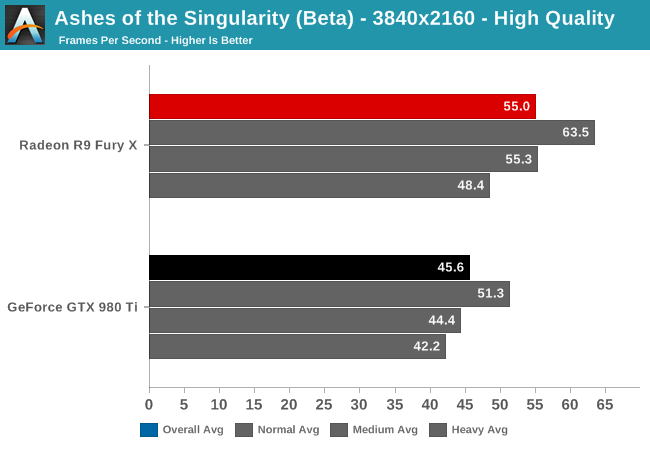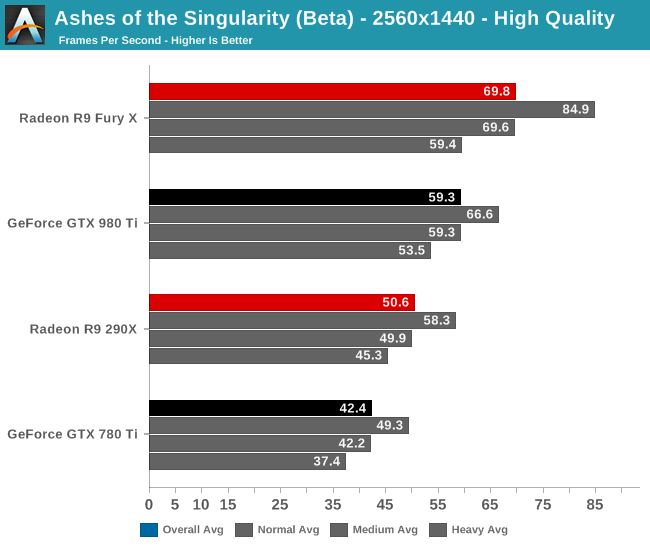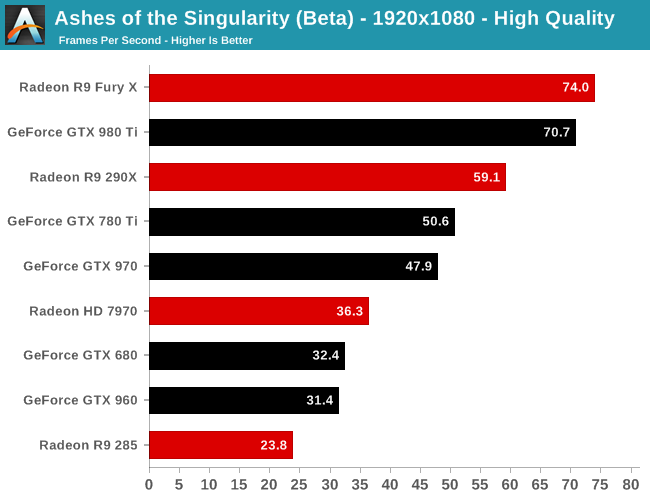Ashes of the Singularity Revisited: A Beta Look at DirectX 12 & Asynchronous Shading
by Daniel Williams & Ryan Smith on February 24, 2016 1:00 PM ESTDirectX 12 Single-GPU Performance
We’ll start things off with a look at single-GPU performance. For this, we’ve grabbed a collection of RTG and NVIDIA GPUs covering the entire DX12 generation, from GCN 1.0 and Kepler to GCN 1.2 and Maxwell. This will give us a good idea of how the game performs both across a wide span of GPU performance levels, and how (if at all) the various GPU generational changes play a role.
Meanwhile unless otherwise noted, we’re using Ashes’ High quality setting, which turns up a number of graphical features and also utilizes 2x MSAA. It’s also worth mentioning that while Ashes does allow async shading to be turned off and on, this option is on by default unless turned off in the game’s INI file.

Starting at 4K, we have the GeForce GTX 980 Ti and Radeon R9 Fury X. On the latest beta the Fury X has a strong lead over the normally faster GTX 980 Ti, beating it by 20% and coming close to hitting 60fps.

When we drop down to 1440p and introduce last-generation’s flagship video cards, the GeForce GTX 780 Ti and Radeon R9 290X, the story is much the same. The Fury X continues to hold a 10fps lead over the GTX 980 Ti, giving it an 18% lead. Similarly, the R9 290X has an 8fps lead over the 780 Ti, translating into a 19% performance lead. This is a significant turnabout from where we normally see these cards, as 780 Ti traditionally holds a lead over the 290X.
Meanwhile looking at the average framerates with different batch count intensities, there admittedly isn’t much remarkable here. All cards take roughly the same performance hit with increasingly larger batch counts.

Finally at 1080p, with our full lineup of cards we can see that RTG’s lead in this latest beta is nearly absolute. The 2012 flagship battle between the 7970 and the GTX 680 puts the 7970 in the lead by 12%, or just shy of 4fps. Elsewhere the GTX 980 Ti does close on the Fury X, but RTG’s current-gen flagship remains in the lead.
The one outlier here is the Radeon R9 285, which is the only 2GB RTG card in our collection. At this point we suspect it’s VRAM limited, but it would require further investigation.










153 Comments
View All Comments
Beany2013 - Wednesday, February 24, 2016 - link
You are aware that Mantle and DX12 are actually different APIs, yeah?zheega - Wednesday, February 24, 2016 - link
AMD just released new drivers that say are made for this benchmark. Can we get a quick follow-up if their performance improves even more??http://support.amd.com/en-us/kb-articles/Pages/AMD...
AMD has partnered with Stardock in association with Oxide to bring gamers Ashes of the Singularity – Benchmark 2.0 the first benchmark to release with DirectX® 12 benchmarking capabilities such as Asynchronous Compute, multi-GPU and multi-threaded command buffer Re-ordering. Radeon Software Crimson Edition 16.2 is optimized to support this exciting new release.
revanchrist - Wednesday, February 24, 2016 - link
See? Every time when there's a pro AMD game tested, there'll be much butt hurt fanboy comments. And i guess everyone knows why. Because when you bought something, you'll always want to justified your purchase and you know who's got the lion share of the dGPU market now. Guess nowadays people are just too sensitive or has a heart of glasses, which makes them judging things ever so subjectively and personally.Socius - Wednesday, February 24, 2016 - link
For anyone who missed it:"Update 02/24: NVIDIA sent a note over this afternoon letting us know that asynchornous shading is not enabled in their current drivers, hence the performance we are seeing here. Unfortunately they are not providing an ETA for when this feature will be enabled."
ToTTenTranz - Wednesday, February 24, 2016 - link
"Unfortunately they are not providing an ETA for when this feature will be enabled."If ever...
andrewaggb - Wednesday, February 24, 2016 - link
Makes sense why it would be slightly slower. Also makes through benchmarks less meaningfulExt3h - Wednesday, February 24, 2016 - link
"not enabled" is a strange and misleading wording, since it obviously is both available and working correctly according to the specification.Should be read as "not being made full use of", as it is only lacking any clever way of profiting from asynchronous compute in hardware.
barn25 - Thursday, February 25, 2016 - link
If you google around you will find out nvidia does not have asynchornous shading on its DX"12" cards. this was actually first found out in WDDM 1.3 back in windows 8.1 when they would not support the optional features which AMD does.Ext3h - Thursday, February 25, 2016 - link
I know that the wrong terminology kept being used for years now, especially driven by major tech review websites like this one. But that's still not making it any less wrong.The API is fully functional. So the driver does support it. Whether it does so efficiently is an entirely different matter, you don't NEED hardware "support" to provide that feature. Hardware support is only required to provide parallel execution, as opposed to the default sequential fallback. The latter one is perfectly within the bounds in the specification, and counts as fully functional. It's just not providing any additional benefits, but it's neither broken nor deactivated.
barn25 - Thursday, February 25, 2016 - link
Don't try to change it. I am referring to HW Asyc compute, which AMD supports and NVidia does not. Using a shim will impact performance even greater.